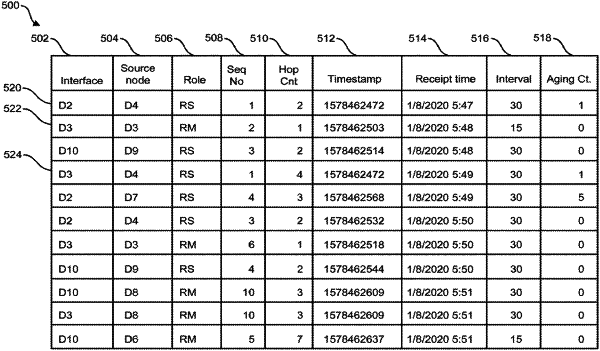| CPC H04L 45/021 (2013.01) [H04L 45/20 (2013.01); H04W 8/005 (2013.01); H04W 40/24 (2013.01); H04W 40/242 (2013.01); H04W 84/18 (2013.01)] | 16 Claims |

|
9. A method for operating a node device having a and memory and a network node ID, the node device connected to a plurality of adjacent nodes in a mesh network including first and second adjacent nodes, each node of the mesh network having a respective unique network node IDs, the method comprising the steps of:
generating a first originated device presence (“DP”) message, each DP message comprising an origination node ID value and a hop count value, wherein the first originated DP message origination node ID value is the node ID of the communication device and the hop count value is one;
sending the first originated DP message to the first adjacent node and the second adjacent node;
receiving an incoming DP message from the first adjacent node;
accessing a device presence table in the memory, the device presence table comprising records, each record having respective a source node value, an origination node value, and a hop count value
storing a new record in the device presence table, the new record associated with the incoming DP message and having the respective ID of the first adjacent node as the corresponding record source node value, having the respective origination node ID value in the incoming DP message as the particular record origination mode value, and the respective hop count value in the incoming DP message as the respective record hop count value;
sending an outgoing DP message to the second adjacent node on the network, the outgoing DP message having as the respective origination node value the origination node value of the incoming DP message and having as the respective hop count value the hop count of the incoming DP message incremented by one;
receiving a first communication directed to a destination; and
in response to receiving the first communication, generating a first non-DP message comprising a payload and specifying a destination node ID corresponding to the destination, and sending the first non-DP message to a particular adjacent node selected using record data in the device presence table.
|